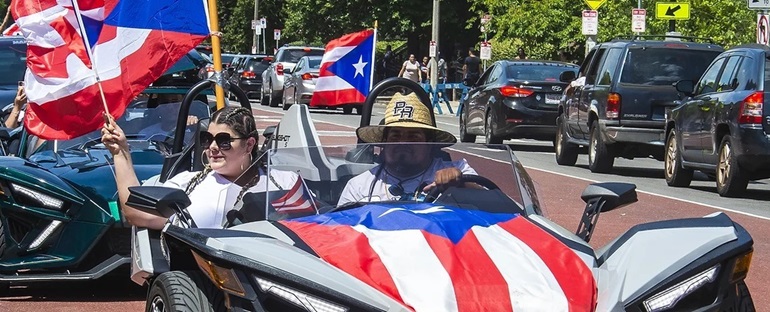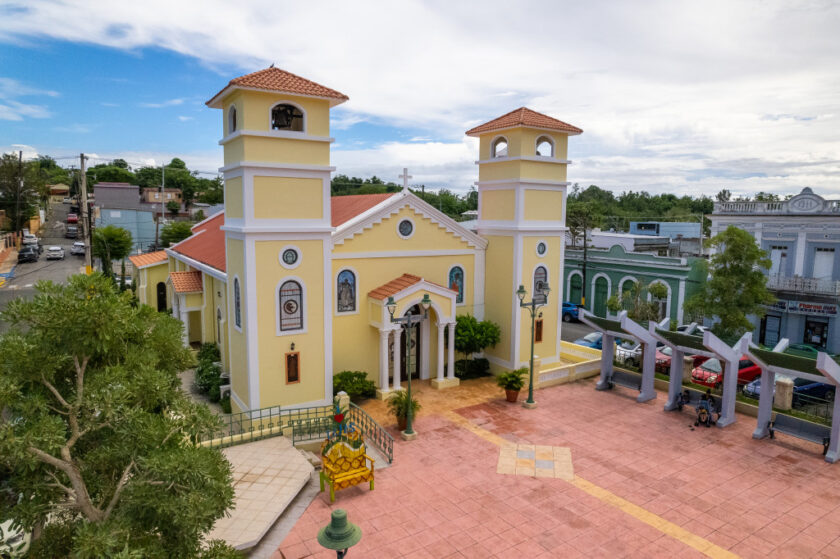[caption id="attachment_18538" align="alignnone" width="599"] Image by Rio Mar Country Club on Rio Mar Country Club[/caption]
Image by Rio Mar Country Club on Rio Mar Country Club[/caption]
Puerto Rico, with its stunning landscapes, rich culture, and world-class golf courses, is an ideal destination for golf enthusiasts. But this Caribbean island offers more than just fine golfing experiences; it also boasts beautiful beaches, outdoor adventures, and vibrant nightlife.
Read through our golfer’s guide to exploring Puerto Rico so you can put together your perfect travel itinerary! Golf, fun, and adventure included. Pack your irons, and let’s go!
Getting To Puerto Rico
Traveling to Puerto Rico is fairly straightforward. You’ll need to check regulations and restrictions from your home country to make sure you’re able to travel with ease.
- Flights: Major airlines offer direct flights to Puerto Rico. San Juan’s Luis Muñoz Marín International Airport (SJU) is the main airport, but you can also fly to smaller airports like Rafael Hernández Airport (BQN) in Aguadilla or Mercedita Airport (PSE) in Ponce.
- Documentation: U.S. citizens don’t need a passport to travel to Puerto Rico. If you’re coming from elsewhere, you probably need a visa. Check this out in advance.
- Special Considerations: Check for any travel advisories or requirements related to COVID-19, other health conditions, or anything else. Stay updated with the latest information from the Puerto Rico Tourism Company or your airline.
Best Golf Courses in Puerto Rico
East Coast Gems
Rio Mar Country Club
Located in Rio Grande, the Rio Mar Country Club has two exceptional golf courses. The Ocean Course has breathtaking views of the Atlantic Ocean and challenging holes that use the natural landscape.
The River Course provides a different experience with its unique layout along the Mameyes River. The club also offers a full-service pro shop, practice facilities, and several dining options, making it a perfect destination for a day of golf.
El Conquistador Resort
Situated in Fajardo, El Conquistador Resort boasts the scenic Arthur Hills Golf Course, renowned for its stunning views of the El Yunque Rainforest and the Atlantic Ocean. The course features 18 holes with exciting elevations, cleverly placed bunkers, and water hazards that test even the most experienced golfers.
The resort’s luxurious amenities, including a full-service spa, multiple restaurants, and a private island, complement the golfing experience. Enjoy a round of golf in a tropical paradise, but take advantage of the resort’s other recreational activities, such as tennis, water sports, and hiking.
Central Highlights
Dorado Beach Golf Club
Located in Dorado, this luxurious golf club offers two world-class 18-hole courses designed by Robert Trent Jones Sr. The East Course has stunning ocean views and a challenging layout. The Sugarcane Course provides a beautiful yet demanding experience. Experienced golfers will appreciate both courses.
Dorado Beach Golf Club is part of the Ritz-Carlton Reserve, with top-notch amenities and service for an unforgettable golfing experience. Visitors can also enjoy the beach, spa, and fine dining options available on-site.
Michael Jordan’s Golf Club @ Bahia Beach
Situated within the St. Regis Bahia Beach Resort in Rio Grande, this exclusive golf club is part of a 483-acre nature reserve. The course features scenic views of the Atlantic Ocean, pristine lakes, and native tropical foliage.
Michael Jordan’s Golf Club also provides luxury amenities such as a full-service clubhouse, gourmet dining, and access to the resort’s private beach, making it a perfect destination for golf enthusiasts seeking a mix of sport and relaxation.
West Coast Treasures
Royal Isabela Golf Links
Royal Isabela Golf Links is a standout golf course located on the northwest coast of Puerto Rico, with breathtaking ocean views and a challenging layout that features rugged cliffs, natural dunes, and lush vegetation.
Each hole is thoughtfully integrated into the natural landscape, making it both interesting and immersive. The course spans 7,538 yards and offers a par 72 layout, with various tee options to suit different players. With luxurious accommodations and fine dining at the Royal Isabela resort, it’s the perfect destination for a golf getaway.
Punta Borinquen Golf Club
Punta Borinquen Golf Club, located in Aguadilla, is one of Puerto Rico’s oldest and most beloved golf courses. This historic course was originally designed in 1940 for the U.S. military and has since become a favorite among locals and tourists alike.
Situated on a cliff overlooking the Atlantic Ocean, Punta Borinquen offers stunning sea views and cooling breezes, enhancing the overall golfing experience. The course is known for its wide fairways, well-maintained greens, and challenging layout that includes several elevation changes and strategically placed bunkers.
Golf Resorts and Accommodation
Luxury Resorts
St. Regis Bahia Beach Resort
The St. Regis Bahia Beach Resort, located in Río Grande, offers a luxurious experience for golf enthusiasts. This resort features an 18-hole championship golf course surrounded by lush tropical landscapes, scenic lakes, and beautiful ocean views, a challenging yet enjoyable experience for players of all levels.
Guests can also enjoy the resort’s world-class amenities, including fine dining, a spa, and elegant accommodations with stunning views of the Atlantic Ocean or the El Yunque National Forest.
Ritz-Carlton Reserve, Dorado Beach
The Ritz-Carlton Reserve, Dorado Beach, is a premier destination for golfers seeking luxury and relaxation. Located on the northern coast of Puerto Rico, this resort features two 18-hole championship golf courses.
These courses offer breathtaking oceanfront holes, lush fairways, and a unique blend of natural beauty and challenging play. The resort provides opulent accommodations, including beachfront suites and residences, fine dining options, a world-renowned spa, and exceptional service.
Budget-Friendly Options
Villa Montaña Beach Resort
Villa Montaña Beach Resort offers an affordable yet luxurious stay for golfers. Located in Isabela, this resort provides access to pristine beaches and stunning ocean views. The resort features comfortable rooms and villas, each equipped with modern amenities such as free Wi-Fi, flat-screen TVs, and kitchenettes.
Golf enthusiasts can enjoy the nearby Royal Isabela Golf Course, renowned for its beautiful scenery and challenging layout. The resort also offers a variety of recreational activities, including tennis, cycling, and water sports, making it an excellent choice for budget-conscious travelers looking for a mix of relaxation and adventure.
Parador Villas del Mar Hau
Parador Villas del Mar Hau is a charming and budget-friendly option located in the town of Isabela. This beachfront property offers a range of accommodations from standard rooms to fully equipped villas, perfect for families or groups. Guests can enjoy direct access to the beach, a swimming pool, and on-site dining at Olas y Arena, which serves delicious local cuisine.
Golfers staying at Parador Villas del Mar Hau can take advantage of the nearby Punta Borinquen Golf Club, known for its historic course and stunning ocean views. This Parador provides a serene and affordable retreat with plenty of opportunities for relaxation and golfing.
Local Culture and Off-Course Activities
Puerto Rico is not only a golfer’s paradise but also a vibrant destination rich in culture and activities that can enhance your visit! Here’s a glimpse of what you can explore beyond the golf courses.
Outdoor Adventures
Rainforest Hikes in El Yunque
El Yunque National Forest, the only tropical rainforest in the U.S. National Forest System, is a must-visit for nature lovers. Located in northeastern Puerto Rico, El Yunque offers a variety of trails that cater to different skill levels.
Popular hikes include the La Mina Trail, which leads to the stunning La Mina Falls, and the El Yunque Peak Trail, offering panoramic views of the island. The forest is home to diverse flora and fauna, including the Puerto Rican parrot and various species of orchids. Visitors can also enjoy refreshing dips in natural pools and waterfalls along the trails.
Beach Activities and Watersports
Puerto Rico's coastline boasts some of the most beautiful beaches in the Caribbean, perfect for a range of activities. In San Juan, Condado Beach is ideal for swimming and sunbathing, while Ocean Park Beach attracts windsurfers and kiteboarders.
For snorkeling and diving, head to the clear waters of Vieques or Culebra islands, where you can explore vibrant coral reefs and underwater wildlife. Surfing enthusiasts should visit Rincon, which is known for its excellent waves and surf culture. Paddleboarding and kayaking are popular in calm areas like Boquerón and Luquillo, providing a serene way to explore the island's coastal beauty.
Travel Tips for Golfers
Best Time to Visit
Puerto Rico’s tropical climate makes it an appealing destination year-round. However, the best time to visit for golf is during the dry season, which runs from mid-December to April. During this period, the weather is pleasantly warm with lower humidity and less rainfall, which are ideal conditions for golfing. The winter months also attract more tourists, so booking your trip and tee times in advance is advisable. Avoiding the hurricane season from June to November is also recommended to make sure your trip is uninterrupted by severe weather.
Packing Essentials for a Puerto Rico Golf Trip
When packing for a golf trip to Puerto Rico, consider both the tropical climate and the golfing requirements. Here are the must-haves, aside from your golf clubs:
- Lightweight, Breathable Golf Attire: Opt for moisture-wicking shirts and shorts to stay cool and dry.
- Golf Shoes with Good Grip: Courses can be dewy in the morning, so shoes with excellent traction are beneficial.
- Wide-brimmed Hat and Sunglasses: Protect yourself from the strong sun.
- Sunscreen: A high-SPF sunscreen is a good idea; sunburn can ruin your trip!
- Insect Repellent: This is particularly important if you’re playing in the early morning or late afternoon.
- Reusable Water Bottle: Staying hydrated is key in the warm climate.
- Rain Gear: Lightweight rain jacket and an umbrella, as sudden showers can occur.
- Portable Charger: For your phone or GPS device to make sure they last through multiple rounds.
Navigating the Language and Local Etiquette
Puerto Rico is a Spanish-speaking territory, but English is widely spoken, especially in tourist areas and golf resorts. However, learning a few basic Spanish phrases can be helpful and appreciated by locals. Here are some tips on local etiquette:
- Politeness Matters: Puerto Ricans value courteous behavior. Always greet with a "Buenos días" (Good morning) or "Buenas tardes" (Good afternoon).
- Tipping: Similar to the mainland US, tipping 15 to 20% in restaurants is customary. Tips for golf caddies and other service staff are also appreciated.
- Dress Code: While Puerto Rico is generally laid-back, dress neatly in public places and adhere to the dress codes at golf courses and resorts.
- Pace of Play: Be mindful of maintaining a steady pace during your game. Let faster groups play through if necessary.
- Respect the Environment: Puerto Ricans take pride in their natural surroundings. Dispose of trash properly and respect the course rules regarding wildlife and plant life.
About the Author
Jordan Fuller is a retired golfer and businessman. When he’s not on the course working on his own game or mentoring young golfers, he writes in-depth articles for his website, Golf Influence.












 Ingredients:
Ingredients:
 Image by Rio Mar Country Club on
Image by Rio Mar Country Club on 














